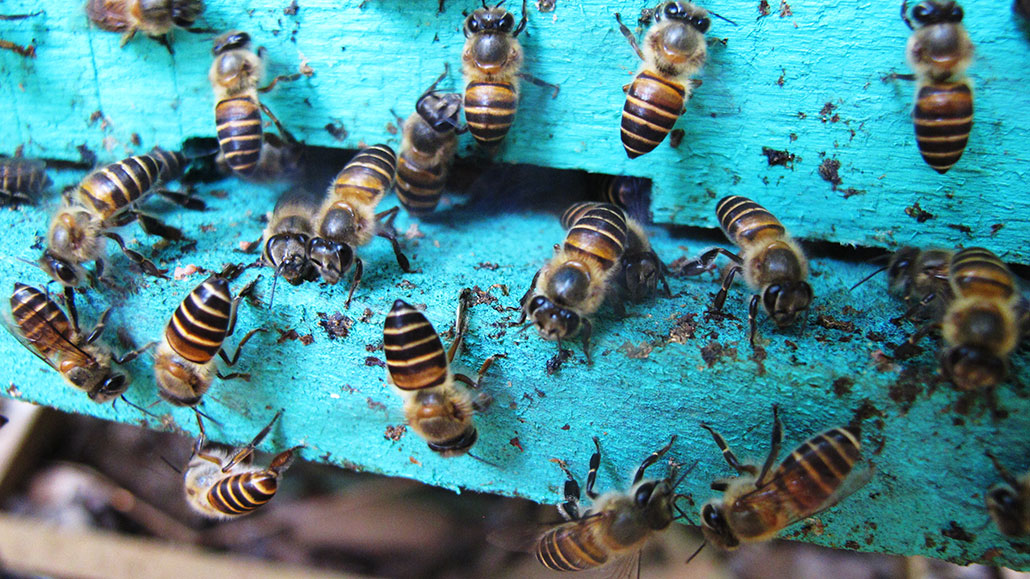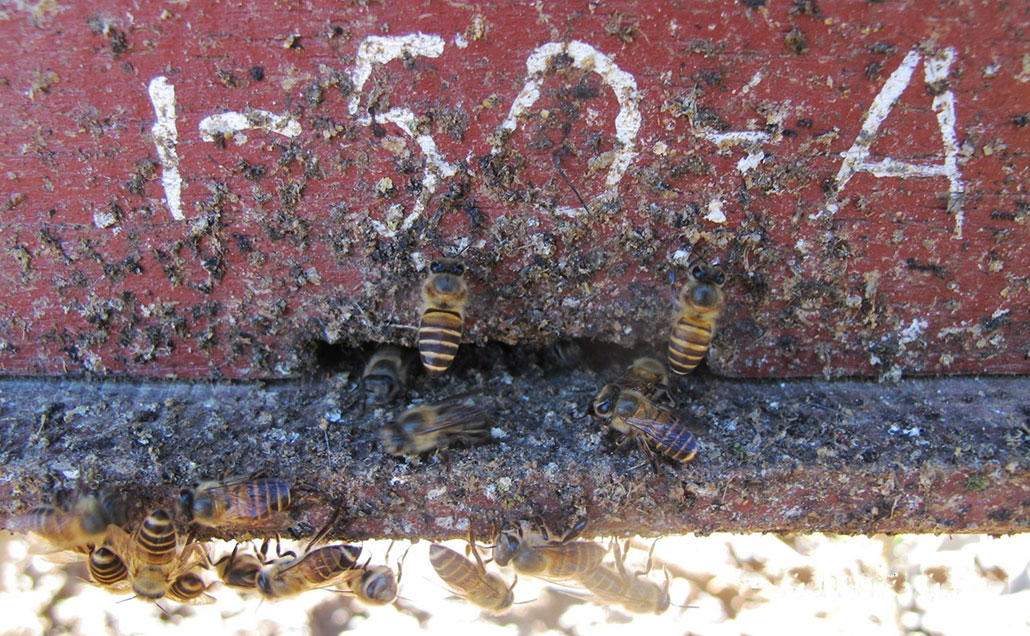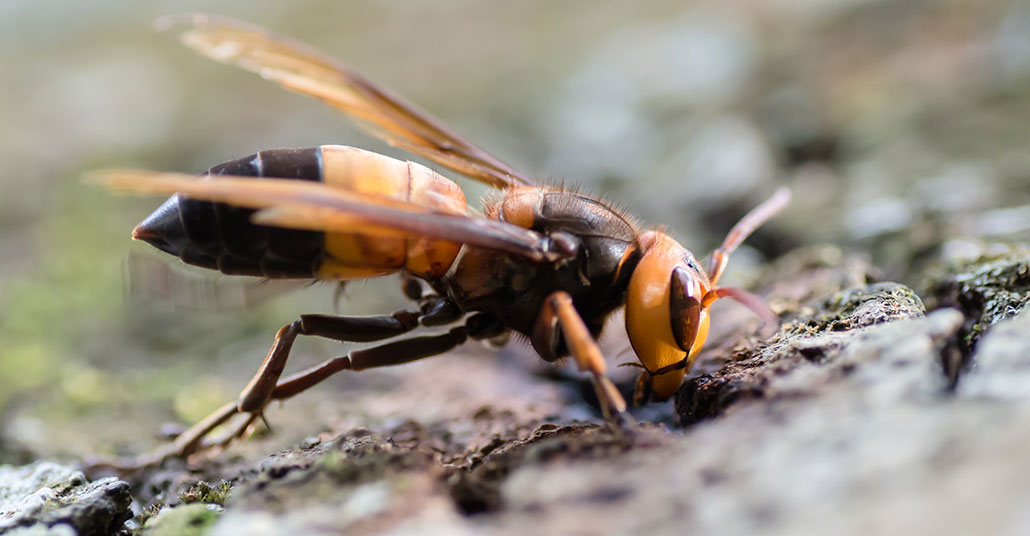Honeybees fend off deadly hornets by decorating hives with poop
Researchers say this odd behavior, called fecal spotting, is a new type of tool use

Asian honeybees collect animal dung and apply small clumps of it to the entrance of a blue-colored hive. This “fecal spotting” behavior deters predatory giant hornets.
H. Mattila
Share this:
- Share via email (Opens in new window) Email
- Click to share on Facebook (Opens in new window) Facebook
- Click to share on X (Opens in new window) X
- Click to share on Pinterest (Opens in new window) Pinterest
- Click to share on Reddit (Opens in new window) Reddit
- Share to Google Classroom (Opens in new window) Google Classroom
- Click to print (Opens in new window) Print
By Asher Jones
Giant hornets from Asia can quickly kill off an entire honeybee hive. But bees have found one stinky way to fend off these predators. Their tactic: smearing the entrance to their hives with animal dung.
Honeybees are known for collecting pollen, nectar and tree sap. So Gard Otis was puzzled to find strange, brown spots the size of poppy seeds encrusting beehives in Vietnam, a country in southeast Asia. When a beekeeper told him the smear was buffalo dung, Otis was astonished. “I had never, ever, ever heard of honeybees collecting dung,” he says. Otis is a retired ecologist who studies insect behavior. He used to work at the University of Guelph in Ontario, Canada.
Some hive entrances were “totally coated with poop,” says Heather Mattila. She’s a honeybee biologist at Wellesley College in Massachusetts who also worked on the research. Asian honeybees use this stinky door decoration to protect their hives from a giant hornet (Vespa soror). Otis, Mattila and their colleagues share this new finding December 9 in the journal PLOS ONE.
V. soror and its close relative V. mandarinia are called giant hornets for a reason. At five centimeters (two inches) long, they’re among the world’s largest hornets. “These things are the size of my thumb,” says Otis. “They are absolutely terrifying.”
When they gang up on a honeybee colony, these hornets can wipe out thousands of bees in just a few hours, Otis notes. Then they take over the colony and devour the bees’ honey. They also snatch bee larvae (baby bees) and feed them to the hornets’ own young.
Giant hornets are native to Asia. But V. mandarinia — sometimes called the “murder hornet” — recently invaded Washington State and British Columbia, Canada. Biologists and beekeepers are worried about this new arrival because bees in North America “are kind of defenseless,” notes Otis. Beekeepers in most places around the world raise European honeybees (Apis mellifera). These bees pollinate many of the crop plants that provide food for people. They do not have any defenses against the foreign hornets. “And they get slaughtered,” he says.
An all-natural remedy
Unlike A. mellifera, the Asian honeybee (A. cerana) has coexisted with giant hornets for millions of years. During this time, the Asian bee has developed some nifty tricks to fend off these huge foes.
The most famous defense is “bee balling.” Hundreds of bees rush onto an intruder and vibrate their wing muscles to produce heat. A writhing ball of bees “cooks” or smothers a hornet to death, says Mattila. Another approach is to swarm the exterior of a hive, after which the mass of bees does the “wave” — a coordinated series of rippling movements. It makes the hive appear to shimmer, which also can send giant hornets packing.
What some of these bees do with another animal’s doo-doo seems to accomplish the same feat.
To confirm that bees collected poop, the researchers gathered dung from chickens, water buffalos, pigs and cows. They placed piles of the feces near beehives. Then they waited.
“We called it the dung buffet,” says Mattila. “It was gross. We were sitting there in really hot weather beside large piles of animal poop. It didn’t smell good,” she laughs. Luckily, they didn’t wait long before visitors arrived to sample the buffet.
The insects collected mouthfuls of dung and then made a beeline back to their hive. There, they pasted small blobs and specks of dung around hive entrances. It kind of looked as “if you took cookie dough and threw it at the wall,” Mattila says. The researchers call this behavior “fecal spotting.”

Next, the test phase
To evaluate why the bees did this, the researchers conducted a test. They cleaned old dung off the hives. Then they again sat and watched. At 14 hives, the researchers used a balloon tied to a stick to chase off hornets, says Otis. Without these bothersome hornets, the bees added just a few dung spots. At 12 other hives, the researchers allowed V. soror hornets to visit. And at these hives, the bees applied hundreds of spots.
The researchers sometimes saw bees doing an “emergency dance” when hornets were near. It was similar to the waggle dance that bees use to tell each other where to find food. But here it appeared the bees were alerting nestmates of danger. Says Mattila, “It’s probably a way of saying ‘We need to start protecting our entrance and we need you to help go get the materials.’”
Her team also recorded hornet attacks on video. The average hornet visit was about 100 seconds at lightly spotted hives. But at hives with a moderate or heavy coating of dung, visits were only around 60 seconds. More poop also meant fewer group attacks: About 25 percent of attacks involved multiple hornets at lightly spotted hives. Only 7 to 15 percent of attacks involved multiple hornets at the grubbier hives.

V. soror spent about 77 to 81 percent less time at hives with moderate or heavy spotting than those that were lightly spotted. The hornets also spent 94 percent less time chewing at filthy hive fronts. This suggests that a dirty doorway keeps hornets from trespassing on the hive.
Exactly how poop deters the hornets is still a mystery. The stench might mask the scent that hornets use to mark hives for attack. It might also disguise the bees’ odor. Or hornets might just lose their appetite at the stench, the scientists conclude.
Truly a tool?
Fecal spotting is the first clear example of honeybees using tools, say Mattila and Otis. It was once thought that only humans used tools. But scientists have since found that many animals do, too — including primates, elephants, crows and even ants.
What makes something a tool? Scientists still argue over that. “Almost everyone agrees that it has to be an external object,” says Natasha Mhatre. It can’t be part of the animal’s own body. And it has to serve a purpose. Many scientists also think that a tool can’t be a nest or something the animal lives in, she adds. Mhatre is a biologist at the University of Western Ontario in Canada. She studies communication in insects and spiders. And while she did not take part in the new research, she agrees that the bees’ dung spotting “seems to fit the criteria for tool use.”
Nor are bees the first insect to use poop as a defense. Some beetles wear armor made of their own poop to avoid getting eaten. It’s called a fecal shield. But bee biologist James Nieh has never heard of social insects like bees using dung as a defense. Nieh studies animal communication at the University of California, San Diego.
Some species of stingless bees will make nests from cow dung. “It’s a good building material,” he explains. But, he adds, “I’d never thought about [dung] in terms of potential repellency, which is very interesting.”
Otis hopes this study shows that you don’t need high-tech equipment or amazing ideas to do science. “There are still cool things to be discovered. They just require good observation.”







